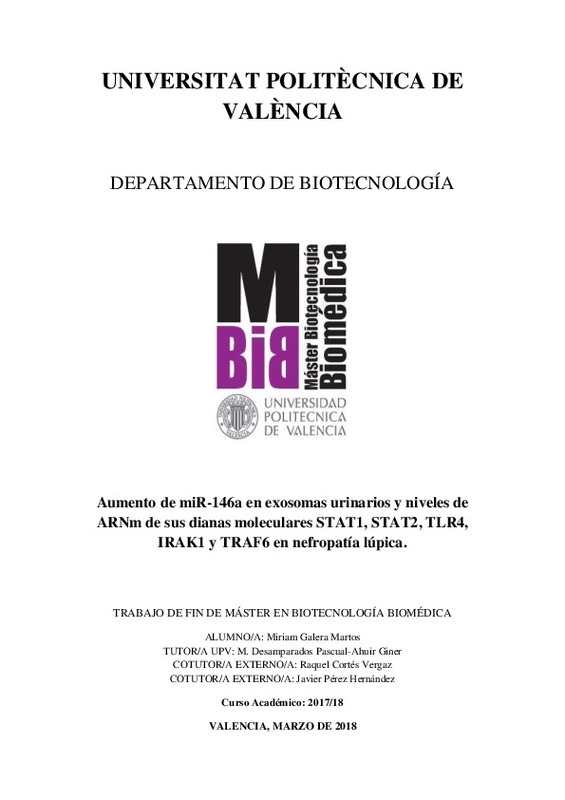|
Resumen:
|
El lupus eritematoso sistémico (LES) es una enfermedad autoinmune crónica en la que se producen autoanticuerpos frente ADN de doble cadena y otros componentes nucleares y citoplasmáticos que afectan a numerosos órganos, ...[+]
El lupus eritematoso sistémico (LES) es una enfermedad autoinmune crónica en la que se producen autoanticuerpos frente ADN de doble cadena y otros componentes nucleares y citoplasmáticos que afectan a numerosos órganos, siendo la afectación renal nefropatía lúpica" (NL) la más frecuente. En el desarrollo de esta enfermedad parece jugar un papel importante la comunicación intercelular vía vesículas extracelulares (VE), sobretodo exosomas (Ex), que contienen proteínas, ARN mensajero (ARNm), micro ARN (miARN) y ADN, y que están presentes en fluidos biológicos. Se ha visto que la expresión de miARNs está modulada en el contexto del LES, especialmente cuando se produce NL activa (NLA), lo que sugiere que los miARNs tienen una función relevante en la patología. El miARN miR-146a , en concreto, se ha encontrado 100 veces aumentado en Ex en NLA, siendo capaz de discriminar la presencia o no de esta condición. El objetivo de este trabajo es cuantificar si hay mayor cantidad de miR-146a en Ex que en microvesículas (MV); comprobar si se observa incremento de este miARN, tanto en Ex como MV, en pacientes de LES con NL respecto al grupo control o pacientes sin NL; y estudiar el efecto sobre la expresión de las dianas moleculares de miR-146a, STAT1, STAT2, TLR4, IRAK1 y TRAF6, involucradas en la activación de genes de respuesta inflamatoria. Se obtuvieron muestras de orina de 40 pacientes de LES, 15 de los cuales con NLA y 10 con NL en remisión (NLR), además de 20 controles sanos. El aislamiento de las VE (Ex y MV) se realizó por ultracentrifugación diferencial. Se extrajo el ARN total de las VE para cuantificar los niveles de miR-146a y del sedimento urinario (pellet celular, PC) para la cuantificación de ARNm, en ambos casos mediante RT-qPCR. Los resultados muestran un incremento significativo de los niveles de miR-146a en Ex respecto a MV en el grupo de pacientes con NLA (20 veces, p< 0.0098). La cantidad de miR-146a exosomal en NLA se vio 79 veces aumentada frente al grupo control (p <0.0001), 39 veces respecto a NLR y 26 veces frente a LES sin NL. Además, los niveles exosomales de miR-146a correlacionaron directamente con la albuminuria (r = 0.684, p< 0.001). Por último, se observó una disminución de los niveles de ARNm de las moléculas diana de miR-146a en pacientes con LES, especialmente con NLA. En conclusión, el nivel de miR-146a sería un potencial marcador no invasivo de NLA, estando asociado a la excreción de albúmina.
[-]
Systemic lupus erythematosus (SLE) is a chronic autoimmune disease in which autoantibodies are produced against double-stranded DNA and other nuclear and cytoplasmic components and affect many organs. Renal affectation ...[+]
Systemic lupus erythematosus (SLE) is a chronic autoimmune disease in which autoantibodies are produced against double-stranded DNA and other nuclear and cytoplasmic components and affect many organs. Renal affectation lupus nephritis (LN) is the most frequent one. Intercellular communication by extracellular vesicles (EV), especially exosomes (Ex), which contain proteins, messenger RNA (mRNA), micro RNA (miRNA) and DNA, and which are present in biological fluids, seems to play an important role in the development of this disease. It has been shown that miRNA expression is modulated in SLE, especially in active LN (ALN), which suggests that miRNAs have a relevant role in the pathology. MicroRNA-146a (miR-146a), in particular, has been found to be 100-fold increased in Ex in NLA, being able to discriminate the presence or not of this condition. The objective of this work is to quantify whether there is a higher amount of miR-146a in Ex than microvesicles (MV); to check whether there is an increase of this miRNA (both in Ex and MV) in SLE patients with LN compared to the control group or patients without LN; and to study the effect on the expression of miR-146a molecular
targets, STAT1, STAT2, TLR4, IRAK1 and TRAF6, involved in the activation of inflammatory response genes. Urine samples were collected from 40 patients with SLE, 15 of whom with ALN and 10 with LN with remission (RLN), and 20 healthy controls. Extracellular vesicles (Ex and MV) purification was performed by differential ultracentrifugation. Total RNA was extracted from EVs to quantify miR-146a levels and from the urine cell pellet (UCP) for mRNA quantification, in both cases by RT-qPCR. The results showed a significant increase in miR-146a levels in Ex compared to MV in ALN patients (20-fold, p < 0.0098). The amount of exosomal miR-146a in ALN showed a 79-fold change compared to that for controls (p < 0.0001), a 39-fold change compared to LN in RLN and a 26-fold change compared to SLE without LN. In addition, exosomal miR-146a levels correlated directly with albuminuria (r = 0.684, p < 0.001). Finally, a decrease in mRNA levels of miR-146a target molecules was observed in patients with SLE, especially with ALN. In conclusion, miR-146a levels would be a potential non-invasive marker of ALN, being associated with albumin excretion.
[-]
|







